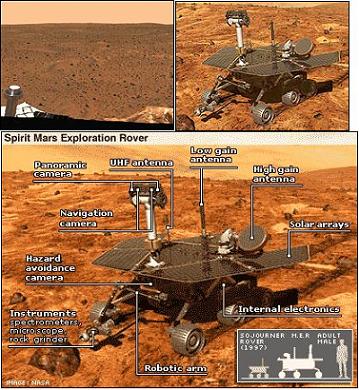NASA has revealed a list of targets on the surface of Mars to which it plans to drive the Spirit robot.

The list of sites to visit includes a nearby crater that a meteor may have fallen into and that may reveal something of the planet's internal geology. The vehicle will continue towards distant hills to learn more about the processes that shape Mars.
The Spirit is supposed to leave the landing pad and roll to the surface in the morning hours of Thursday (15/1/04, today).
We know where we are now and where we want to go, said Steve Squires of Cornell University, the lead scientist on the SPIRIT mission, with a smile. "With this knowledge we can intelligently plan a plan throughout the mission to discover all the secrets of the landing site.:
The scientists decided on these locations after analyzing the surface using radio techniques and photography carried out by the vehicle. "The goal of the mission is to find materials that will tell us whether Gosev Crater once contained a lake or not, and what the conditions were in that lake," said Prof. Squires.
"We will also know soon what the material is that the area is built from, but what is below it, and what is above it? These are questions we would like to answer through the tour.
Spirit will initially perform an analysis of the rocks near its landing site. Next, it will explore a 200-meter-wide crater located 250 meters northeast of its current location. This is a particularly attractive goal. The vehicle will descend to a depth of tens of meters. It will pass by an abyss with a depth of 3-4 maybe even 5 meters. Prof. Squires said.
He explained that it is not yet known what Spirit's exact tasks will be when it reaches the crater, however, as Spirit gets closer to the rim of the crater, it will get closer to the area of the ejecta blanket - the materials that were thrown from the crater as a result of the meteorite impact and which cover an area of about 30 meters near the crater. "This will provide a window into the subsurface of Mars," said Prof. Squires. "Once we do that, we'll be able to look deeper into Mars than we could even hope for on this mission. This is the great crater available to us."
Mission scientist Tim Parker said that most of the crater must have been buried or that the materials inside were blown by the wind or maybe even eroded by the water."
Onward to the hills
After that, the robotic vehicle will travel towards the eastern hills, which can be seen from a distance today from the landing site in the Gosev crater. These hills are about three kilometers from the landing site and the vehicle was designed to travel only 600 meters from its starting point. It is not certain that you can reach the hills, but at least get closer to them and explore the rocks that are on the way. This is to compare them with the rocks from Makhtesh Gusev and allow them to decide whether water flowed in this Evaporite basin.
Jumped 28 times
Spirit has already performed the pyrotechnic maneuver that cut the cable that bound it so it landed and is now free to position itself to roll 3 meters above the surface. The scientists also revealed that the robot bounced 28 times during landing and may also have encountered gusts of wind when touching the ground.
.
